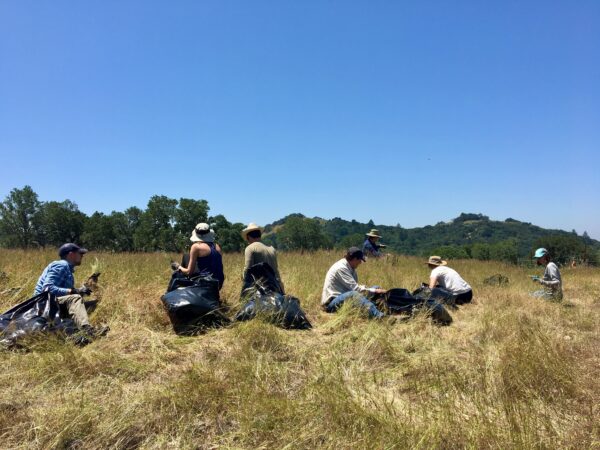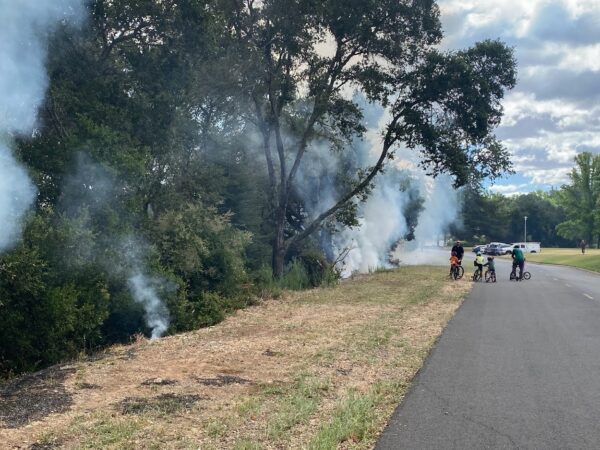February 10, 2025
Posted in: News Articles
While planning may not sound like the most exciting endeavor, it’s an essential step in caring for conserved lands. Early conservationists focused their plans on leaving the land alone as a response to less-than-ideal land management techniques like aggressive forestry, land conversion, and fire suppression. But over time it’s become clear that non-management of land has its own problems, like overgrowth that can crowd out native plants and wildlife, or that offers more fuel for wildfires. And so, what we are now seeing is a return to more active land management, as has been modeled by Indigenous groups for millennia through hunting, gathering, and intentional burning.
A key motivator for more active land management has been the warming of our climate and the associated wildfires seen across the western US. While out enjoying the beauty of our county, it’s become more commonplace to stumble upon grazing goats, or see public alerts for prescribed burns. And along with this need to more actively manage land, comes the need to thoughtfully plan the work for the best outcomes.
At Ag + Open Space, this means we’re more committed than ever to working with landowners to support them in developing land management plans. When a landowner has an Ag + Open Space conservation easement on their property, that easement outlines what cannot be done on the property, but it also guides land uses that support the balance and health of the natural resources on the property. For instance, an easement may prohibit the removal native plants, but it also might encourage pro-active management of the land that helps support the native plant populations.
Say a landowner wanted to remove yellow star-thistle that’s crowding our native grasses on their property. The landowner could come to Ag + Open Space and explain what they’re wanting to do, and we could provide them with our vegetation management plan template that provides an outline of the steps needed in planning a successful vegetation management project. A thorough plan includes a description of the current conditions of the land, goals for the project, and proposed steps for, in this example, removing a particular invasive plant population. These plans also typically include timelines, any required permits, a map of the project area, and how success will be measured.

Ag + Open Space staff removing an invasive species at Saddle Mountain Open Space Preserve.
Now, our support doesn’t stop at providing the template. As landowners develop their plans, Ag + Open Space staff are available to provide resources on best practices, ensure the plan is in alignment with the easement, and to guide landowners towards partner organizations and government agencies that might be able to provide direct support or funding.
So, what does that look like in the real world? In recent years, Healdsburg Ridge Open Space Preserve and the adjacent privately owned Callahan property (both conserved with Ag + Open Space easements) were threatened or directly impacted by wildfire. Sitting just to the east of Healdsburg, these properties are in what’s known as a wildland-urban-interface, which is where the perimeters of our cities and towns meet natural, open spaces. When effectively managed, open spaces can help buffer urban areas during wildfires, while also providing space for firefighters to stage and create containment lines.
To create these buffers, grazing goats and sheep can be helpful in clearing out ladder fuels – the low vegetation that can help fires move from the ground to the tree canopy. These types of vegetation management projects are meant to provide safe, strategic access to firefighters while giving the fire less opportunity to spread and intensify. Managed landscapes require ongoing maintenance, and grazing goats and sheep can be helpful for this long-term management.

A prescribed burn held by the Good Fire Alliance Network.
The City of Healdsburg has been using grazing as one of their tools to reduce fire risk on these two properties. We supported this work in part by reviewing their grazing plans to ensure this much needed fuel reduction project protected the unique natural features of these lands, while also carefully planning where the animals could roam and what they could eat. We also helped to identify places of greater sensitivity that would need to be either avoided or treated with a lighter touch. For instance, in an area of Healdsburg Ridge, the plans worked around stands of Baker’s manzanita, a very rare federally listed shrub species that is native to Sonoma County, while still prioritizing reduction of fire fuels.
Whether it’s grazing, mowing, a prescribed burn, or any other type of vegetation management project, our Stewardship team is always willing (and excited!) to help support landowners in developing a plan. You can check out our vegetation management plan template here, or peruse some of our favorite resources below:
- Tending the Land – Online resource library for vegetation management and fire resiliency in Sonoma County.
- CalFire’s Wildfire Resilience Programs – Assisting nonindustrial timberland owners with wildfire resilience efforts by providing technical and financial assistance for their forest management needs.
- Burn Pile Guide – Tips for building and extinguishing piles in Sonoma County
If you are interested in discussing vegetation management on your Ag + Open Space conservation easement property, please don’t hesitate to reach out to us at openspace@sonoma-county.org or 707-565-7360.